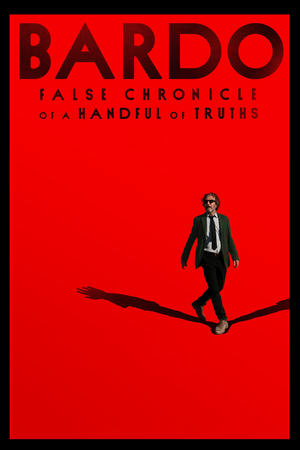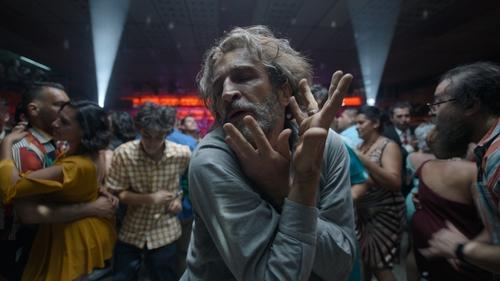Bardo False Chronicle of a Handful of Truths London film premiere 2024
Bardo, False Chronicle of a Handful of Truths is an epic, visually stunning and immersive experience set against the intimate and moving journey of Silverio, a renowned Mexican journalist and documentary filmmaker living in Los Angeles, who, after being named the recipient of a prestigious international award, is compelled to return to his native country, unaware that this simple trip will push him to an existential limit. The folly of his memories and fears pierce through to the present, filling his everyday life with a sense of bewilderment and wonder. With both emotion and abundant laughter, Silverio grapples with universal yet intimate questions about identity, success, mortality, the history of Mexico and the deeply emotional familial bonds he shares with his wife and children. Indeed, what it means to be human in these very peculiar times.

Bardo False Chronicle of a Handful of Truths London Premieres null
- Status: Not information yet
- Date: Not information yet
- Location: Not information yet
- Release in Cinemas: 2022-12-16
- Runtime: 159 minutes
- directors: Alejandro G. Iu00f1u00e1rritu
Planning to attend the film premiere? Find more information regarding tickets, wristbands the times usually the premieres are taking place at London Film Premieres
Wallpapers
If you're someone who loves to personalize your devices with stunning visuals, you simply cannot miss out on the best wallpapers available. Check out Our collection of 4K and HD wallpapers in full colour and high definition Click on the Image below to explore our extensive collection

Watch Bardo False Chronicle of a Handful of Truths Trailer
Did you know ... ?
- Alejandro G. Iñárritu returned to shoot and produce a film entirely in Mexico for the first time since Amores Perros (2000) over twenty years ago.
- Alejandro G. Iñárritu's statement for the 79th Venice International Film Festival: "A few years ago, I suddenly realized the road ahead of me was much shorter than the one I had left behind. Inevitably, I started to explore it backwards and inwards. Both paths are elusive and labyrinthine. Time and space enmesh. The narrative that makes up 'our life' is no more than a false mirage constructed of events experienced subjectively by our limited nervous system. Memory lacks truth. It only possesses emotional conviction. It is the truth in that emotion that I set out to search for in the enormous drawer of chimeras I have been carrying. I must warn you beforehand: I have found no absolute truths. Only a journey between reality and imagination. A dream. Dreams, as cinema, are real but not truthful. In both, time is liquid. BARDO is the chronicle of that journey between those two illusions whose borders are indecipherable."
- Bardo, in Buddhism, is an intermediate, transitional, or liminal state between death and rebirth.
- Alejandro G. Iñárritu edited the film himself for the first time since his debut feature, Amores Perros (2000).
- On April 27 2022, Netflix announced that in addition to acquiring the distribution rights and being available on the streaming platform, the film would be its first wide theatrical release, as opposed to limited theatrical showings. It also was confirmed to be shot on 65mm film, a rarity for streaming services in general.
- With the confirmation that the movie is shot on 65mm film, this will mark Alejandro G. Iñárritu's first film shot on film stock since Biutiful (2010).
- Official submission of Mexico for the "Best International Feature Film" category of the 95th Academy Awards in 2023.
- Following the Venice and Telluride Film Festivals, Iñárritu removed 22 minutes from the film, making the released version 159 minutes.
- The film was previously referred to in reports as "Limbo," but that title was never officially announced.
- The scene in which a border force officer interjects, "This is not your home," is practically a word-for-word re-enactment of something that happened to Alejandro G. Iñárritu's wife in 2020.
- The party scene was shot after six weeks of rehearsals, and included 800 extras.
- Every main character has been color-coded throughout the film: Silverio always wears black, the same suit all over, Lucia dresses in blue, Camila in green, and Lorenzo in yellow.
- As in the film, Alejandro G. Iñárritu and his wife, editor Maria Eladia Hagerman, lost a child just days after he was born.
- According to Alejandro G. Iñarritu, this is "the most complicated film" he has done.
- In September 2021 when the film was announced to have completed filming, allegations were made over social media by several figures in the Mexican film industry that Alejandro G. Iñárritu constantly breached COVID safety protocols, resulting in hazardous working conditions and even the deaths of a number of crew members, with further talk of a class action suit against Iñárritu to follow. As of the film's announced premiere at the Venice Film Festival, no announcement or follow-up has occurred.
- Since it's a shadow flying, it took Alejandro G. Iñárritu almost a year to solve how to do the opening shot.
- Guillermo del Toro praised it by saying, "The movie is undeniably one of the most powerful things I've seen in terms of cinema, pure cinema".
- None of the music included in the party scene was added in post-production.
- Darius Khondji paired the large format Alexa 65 camera with Panavision Sphero lenses, shooting almost the entirety of the film on the 17mm and the 21mm.
- The scene where Hernán Cortés sits atop a pile of corpses takes place in the Zócalo which is the common name of the main square in central Mexico City. Prior to the colonial period, it was the main ceremonial center in the Aztec city of Tenochtitlan. It has been a gathering place for Mexicans as well, having been the site of Mexican ceremonies, the swearing-in of viceroys, royal proclamations, military parades, Independence ceremonies, and modern religious events such as the festivals of Holy Week and Corpus Christi.
- An hour 36 minutes into film, when Silverio is walking in the street in Mexico City, he passes by a business named "La Torre de Babel". In 2006, Alejandro G. Iñárritu directed "Babel".
- Eugenio Caballero, the production designer of the film, received the script before any of the actors. Immediately, he grasped the vivid color palette Alejandro G. Iñarritu envisioned: few primary colors, lots of green, pale rose, and purple. These regulations on hues extended to most inanimate objects, as well as the clothing on the numerous extras.
- When asked, "If someone has actually never seen any of your work before, what is the first thing you'd like them watching?", Alejandro G. Iñárritu replied by saying, "Bardo."
- According to Alejandro G. Iñárritu, "the problem with this film is that all of the fabric of this film is made of elusive emotions, and feelings, and dreams and things, but those things are immaterial, there is no recipe. Then to turn them into an idea, and then to write them, and convert a sequence, and give a reason, and then execute them and flesh them out is super difficult."
- The opening shot is a recurrent dream of Alejandro G. Iñárritu's. In his own words, it's a dream that is pleasant, but at the same time, it's always feeling dangerous because he always feels that he's flying very close to the ground, and that any false movement can really hit the ground. For him, it's like walking the line with some pleasant feeling. Sometimes it disappears for years, and then suddenly comes and it's every day, or every week that he feels the same.
- Among the actors, only Daniel Giménez Cacho was given the whole script.
- According to Alejandro G. Iñárritu, the film was built in 32 sequences. Every sequence, in a way, is blended again with the other one, with no story. And there's no structure. It's only an atmosphere, and the only kind of spine, or middle, or center is emotional. It took him four years to put all that together.
- The Battle of Chapultepec was a battle between American forces and Mexican forces holding the strategically located Chapultepec Castle just outside Mexico City, fought 13 September 1847 during the Mexican-American War. The building, sitting atop a 200-foot (61 m) hill, was an important position for the defense of the city. The battle was part of the campaign to take Mexico City, for which General Winfield Scott's U.S. Army totaled 7,200 men. General Antonio López de Santa Anna, known for vicious attacks against Native Mexican American tribes, had formed an army of approximately 25,000 men. Mexican forces, including military cadets of the Military Academy, defended the position at Chapultepec against 2,000 U.S. forces. The Mexicans' loss opened the way for the Americans to take the center of Mexico City. In Mexican history, the battle is cast as the story of the brave deaths of six cadets, the Niños Héroes, who leapt to their deaths rather than be taken captive, with one wrapping himself in the Mexican flag.
- All the clothes in every scene of film, including and mostly the extras, belongs to different eras of Silverio's lifetime ranging from the sixties to contemporary times.
- Darius Khondji called the script of the film, "maybe the greatest" one that he has ever read.
- For Alejandro G. Iñarritu, the source of inspiration was Jorge Luis Borges, especially Borges' "blending of time and space in a labyrinthine way".
- The opening shot was the first image that came to Alejandro G. Iñárritu's mind.
- According to Alejandro G. Iñárritu, the film "is a walk in the consciousness of a character. All the film is that. It's a lucid dream".
- Alejandro G. Iñárritu did storyboards himself for every scene of the film.
- Pre-production of the film took two years.
- Lorenzo's pet is an axolotls. The species is named after the Aztec deity "Xolotl" who was a god of fire and lightning, was commonly depicted as a dog-headed man and was a soul-guide for the dead, and eventually transformed himself into an axolotl to avoid being sacrificed by fellow gods. They continue to play an out-sized cultural role in Mexico.
- Alejandro G. Iñárritu insists that the film is not an autobiography. It is a fantasia, a dreamscape and, anything but a factual accounting of his life. He claims, "Every autobiography is a lie. Autobiography pretends it owns the truth, that it's making factual claims. But it's not. This is fiction that allows me to explore the emotional kinds of truth."
- According to Alejandro G. Iñárritu, it is the more precise film he has done in his life. For in this film, everything was absolutely pre-planned, rehearsed, controlled, and incredibly specific, every step, every movement, camera, actors. The reason was that the lucid dream sensation cannot be improvised or achieved by chance.
- Has more to do with Jorge Luis Borges than Federico Fellini, according to Alejandro G. Iñarritu.
- Silverio's home was first built in a studio, where scenes were filmed chronologically, the large structure (featuring the main hall, the living room, and the dining room) was later transported over a thousand miles north to the desert town of Melitón Albáñez Domínguez in the Mexican state of Baja California Sur. Ultimately, rain forced them to move to the El Vizcaíno Biosphere Reserve.
- According to Alejandro G. Iñárritu, the film is made in circles as the novel "Rayuela" by Julio Cortázar for one can start the film and the book in the middle, in the beginning, in the end, and it doesn't matter where one goes in. Since it's a circular thing, one will understand everything. Likewise there's no Act One, Act Two, Act Three, plot point. The whole thing is just a dream.
- According to himself, Alejandro G. Iñárritu wanted the film to contain, as in the dreams, always something soft, something that feels real. He wanted to get into a lucid dream, a liquid kind of sensation, to get inside Silverio and how he was feeling about the dream, and "to isolate him, but still be surrounded by a shared loneliness, but enjoying the depth".
- Was inspired by the works of Julio Cortázar and Jorge Luis Borges.
- Was "100 times tougher" to make than The Revenat (2015), according to Alejandro G. Iñárritu.
- Is "the best film he has done," according to Alejandro G. Iñarritu.
- The Chapultepec Castle, where Silverio meets the US ambassador, was built during the Viceroyalty of New Spain as a summer house for the highest colonial administrator, the viceroy. It was given various uses, from a gunpowder warehouse to a military academy in 1841. It was remodeled and added to and became the official residence of Emperor Maximilian I of Mexico and his consort Empress Carlota during the Second Mexican Empire (1864-67). In 1882, President Manuel González declared it the official residence of the President. With few exceptions, all succeeding presidents lived there until 1939, when President Lázaro Cárdenas turned it into a museum. It is located at the entrance to Chapultepec Park at a height of 2,325 meters above sea level. Also, the site of the hill was a sacred place for Aztecs.
- For the Chapultepec Castle scene, the production team faced rigorous limitations to safeguard the historical artifacts, including the delicate carpets on the floor. They recreated the castle's main tower, from which a heroic soldier is said to have jumped, at a 1:1 scale in a parking lot off-site, and then inserted those shots into the scene digitally.
- Is not an autobiography, a journal, a memoir in a traditional, conventional way, rather it is "an intimate auto-fiction that does not claim truth", for Alejandro G. Iñárritu. Hence the the subtitle, "False Chronicle of a Handful of Truths".
- Takes place in the most treacherous place of all, according to Alejandro G. Iñárritu, which is "the personal geography of his existence".
- Bardo premiered at the 79th Venice International Film Festival in competition for the Golden Lion on September 1, 2022, and was released in theaters on November 18, 2022, then streamed on Netflix on December 16, 2022. The film received mixed reviews from critics, who praised the performances of Cacho and Siciliani, Khondji's cinematography, and Iñarritu's direction, but criticized the writing and runtime. It received a nomination for Best Cinematography at the 95th Academy Awards.
- Was shot on the large-format 65mm.
- The surname of the protagonist, "Silverio Gama", is the same as Alejandro González Iñárritu's father's surname: "Héctor González Gama".
- According to himself, Alejandro G. Iñarritu stopped and started writing the film twice during the pandemic. In those early stages, his colleagues cautioned him not to assume he could pull off the outrageous concept he had in mind.
- Has the most deleted scenes, about 30 minutes, among Alejandro G. Iñárritu films, according to himself.
- Was self-financed by Alejandro G. Iñárritu in its early stages. It was later picked up by Netflix.
Genre
Comedy,Drama
Cast













Marco Gomes
I'm a movie enthusiast and creator of London film premieres, a blog sharing upcoming premires in London, films, movies. Contact me at marcogomesr@gmail.com for assistance.
